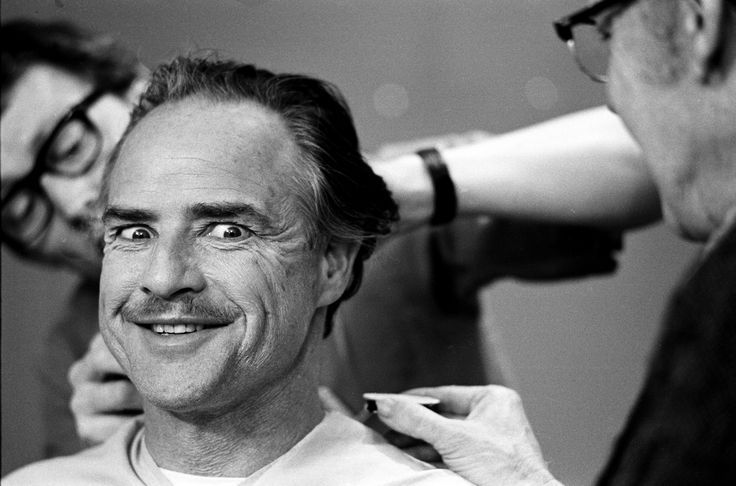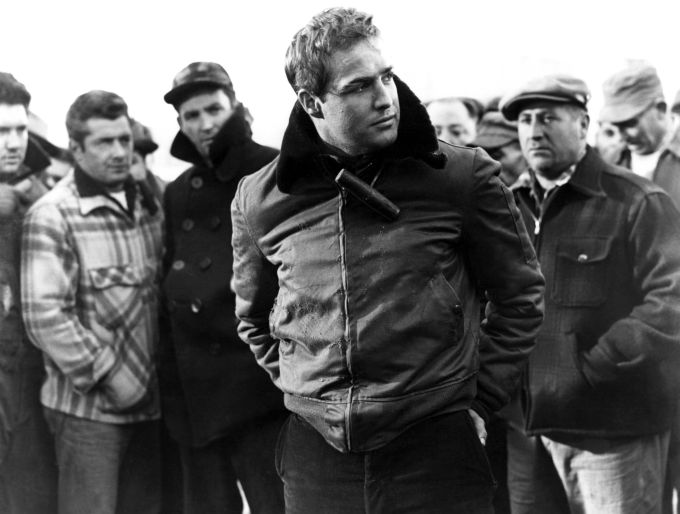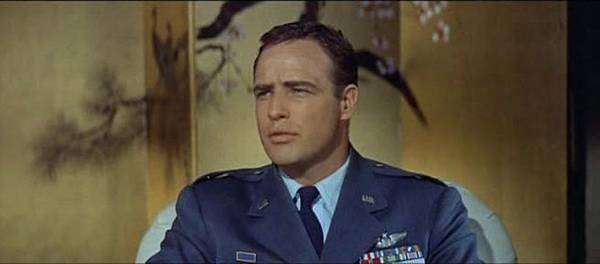However, when talking about Brando, people tend to focus on three or four things. They would probably discuss the sheer intensity and sexual magnetism of his early performances or his mid-career peak as Don Vito Corelone in The Godfather.
 |
| "I'm gonna make them a reference they can't refuse." |
Alternatively, they might mention his passionate, if ill-executed, activism, or his later bloated years making essentially glorified cameos for ridiculous sums of money as he became increasingly difficult to work with, not to mention, increasingly fat.
In whatever case, it cannot be denied that Marlon Brando was one of the most important stars in the history of Hollywood, leaving a definite mark. Even as his fame faded, his stardom was eulogised into myth: a story of a fantastic actor and new type of male sex symbol who seemed to inspire a whole generation before eventually descending into prima donna tendencies and seemingly wasting his prodigious talent in his later years.
The truth is of course more complicated than the myth but I'm not going to try deconstruct the myth of Brando since I really haven't done enough research nor am really interested in doing so.
 |
| I actually would have more interest in just posting pictures of Brando looking moody. |
To be fair, I'm not really interested in discussing the three or four things I mentioned everyone talks about when they talk about Brando in any great detail. This post isn't about The Godfather or his activism. And it is especially not how this once beautiful sex icon didn't age particularly well. That has been well-covered elsewhere online and in print.
However, while I won't go on about his early roles in great depth, I do want to mention them. This is mainly because I had never seen his early iconic performances which made him a star and cemented his place in Hollywood history.
Of course I knew about his famous "I could have been a contender" speech from On The Waterfront and had seen the "Stella! Stella!" scene from A Streetcar Named Desire either on YouTube or referenced in a bazillion different things, including Seinfeld but I had never watched the movies they came from.
 |
| Here's another picture of Brando looking moody. |
So I had me a bit of a Marlon Brando movie marathon this week to catch up on the Brando films I never got round to seeing. And, considering their iconic status, they are unsurprising great. Brando is fantastic, of course, although I could see where the things he was doing was picked up by later actors such as Robert De Niro, Al Pacino, Daniel Day-Lewis, and Tom Hardy (among others) and taken further.
This is not to underplay how fantastically intense and sexual Brando is as Stanley Kolwaski nor how powerfully emotive his performance as Terry Malloy is, but rather just an indication of how what he did then allowed the actors who followed to take it to the next level, building on what he had accomplished.
 |
| Yet another picture of Brando looking moody. |
He definitely brought an intensity and realness to the screen which hadn't been seen before but in breaking that barrier, others sought to push it even further.
One way to think of it is how old movies tend to seem slow to younger audiences. They seem take longer to unfold their narratives with less action, probably because not every one was familiar with the cliches of movie storytelling yet and movies were slower paced. On the other hand, modern movies are incredibly faster paced in comparison, compacting a lot more information in less time with far more action propelling the plot forward leading from one scene to the next.
Similarly, Brando's performances might seem slightly muted in comparison to the intensity of De Niro in Taxi Driver or Raging Bull, Hardy's performance as prisoner Charles Bronson in Bronson, or practically anything Day-Lewis does. Again, this is not to take away from what a fabulous actor he was but rather to highlight how art is built on the work of those who came before us. In this case, the actors who followed in Brando's footsteps, and then the actors who followed in the footsteps of those who followed in Brando's footsteps.
 |
| Just one more picture of Brando looking moody |
However, as a side note, I wanted to talk about how On the Waterfront really made me think of Rocky. You might remember that I wrote about the Rocky movies a while ago after watching them for the first time and noting they were more than I expected for films about a boxer who would eventually punch communism in the face.
Now, in his review of the first Rocky movie, Roger Ebert noted that Sylvester Stallone reminded him of a young Marlon Brando. At the time when I wrote my article on the Rocky series I didn't understand what Ebert meant, but having watched On the Waterfront it makes perfect sense. On the Waterfront is almost like a spiritual predecessor to the first Rocky.
Both are movies about uneducated boxers who could have been contenders but due to circumstances, the chance blew them by. Both characters work as muscle on the docks for a criminal type and dream of being more than being perceived as a bum by those around them.
 |
| Look at him. Just bumming it up. |
On the Waterfront uses Terry's failed boxing history as backstory for a character in a movie which focuses on a blossoming relationship and crime. On the other hand, Rocky's failed boxing history is used as backstory for a character in a movie which focuses on a relationship and the chance to become a contender.
Although attempting to compare the performances of the two would be futile, due to the reverence Brando is held as one of the greatest actors in the history of ever while Stallone has often been dismissed as a mumbling action star, I'm gonna compare their performances with one another. Brando is the better actor for sure, but just like how I mention those who followed Brando took it further, so too does Stallone.
Where Brando's Terry was uneducated and not the smartest man on the dock, like I've discussed in my previous article, Stallone's Rocky is rather slow and borderline mentally challenged. It's almost like Stallone, consciously or otherwise, built on Brando's performance of Terry, or at least let it inform his own. Almost as if he had said to himself, "Yeah, but what if we made him more slow and mumble more?".
 |
| "You say what, now?" |
But what I really want to talk about are two films made in between Brando's early blast on the silver screen and his mid-career high with The Godfather. These films are almost never discussed when people think of Marlon Brando, despite the fact he made some intriguing films during this time, even if they weren't as successful as his early roles or the colossal hit The Godfather was.
Looking through his filmography during this period, two films (ten years apart from each other) stood out to me, Sayonara and Reflections in a Golden Eye. The former because it attempted to deal with interracial marriage in the late 1950s, the later because it dealt with suburban sexual repression and closeted homosexuality in the late 1960s.
Funnily enough, Brando plays military figures in both films, a major in Sayonara and a captain in Reflections. Although these movies were made a decade apart and bear no real relationship to each other, it's an odd thematic coincidence that both films depict a military man struggling with desires beyond what was expected of a 'good' masculine soldier at the time, and arguable today.
 |
| "Wait, they only repealed Don't Ask, Don't Tell how long ago now?" |
First things first, Sayonara is a really good film with rather progressive racial politics. It really tries to depict Japanese culture authentically and even if it might get some things wrong since it is coming from an outsider's perspective, the film is trying to be culturally sensitive, which was unusual for its time. The love between the supporting characters Joe Kelly and Katsumi feels genuine and the film doesn't shy away from all the prejudice and obstacles their interracial union would suffer in the real world.
Similarly, as we see Brando's Llyod "Ace" Gruver develop tolerance and understanding, eventually falling in love with a Japanese woman over his American Southern belle, the film really is a strong message for tolerance and acceptance in the face of racist adversity.
Brando gives deft and rich performance as the 'aw shucks' Southern pilot and general's son who has a clear idea of the future which has been planned out for him and was prepared to follow that path until he finds love. In contrast to the intensity in A Streetcar Named Desire, he is more subdued here depicting the transition from calling Joe's girlfriend slint-eyed in the beginning of the film to eloping with his Japanese fiance at the end of it. The fact that transition is completely believable is a testament to Brando's talent.
 |
| "Aw shucks." |
Unfortunately, the film does suffer from the not-so casual racism of the times since the primary Japanese male lead is played by a Mexican in yellow-face. This might be a symptom of sexism too, for while it seems the film is totally okay with having Japanese actresses play Japanese female roles, apparently a supporting Japanese male character can't be played by a Japanese man for some reason.
But moving on, since if we get bogged down in the complex racial and sexual politics at work here, we'll never get past it, let's talk about Reflections in a Golden Eye. Starring Brando with Elizabeth Taylor, this appears to be a movie which time wanted to forget.
The movie bombed on its release and wasn't well-received by most critics at the time, Time Magazine didn't like it, while Variety called it a "pretentious melodrama" and didn't think to highly of Brando's performance. On the other hand, Roger Ebert praised the film and Brando's performance, stating it was a return to his peak after a run of poor films. He even took to chastise the audience in the cinema for their homophobic response to laugh at Brando brushing his hair when he thinks a private is coming to see him in his room.
 |
| "Why would they do that?" |
When watching the film, it struck me how the primary theme, aside from repression, was perception, or rather keeping up the facade of normality while harbouring desires or tendencies outside of society's expectations. This is not limited to Brandon's Captain Penderton but also Tayler's Leonora who is having an affair with their neighbour and Penderton's superior officer.
This is a film about performance, where people struggle to perform the roles assign to them by society. There is a scene where Penderton practices his salute and smiling in the mirror. It is a rehearsal but you can just see the cracks in his performance, where he is struggling to keep up the act.
Furthermore, the character of Penderton almost seems like a retort to the sex icon status Marlon got for his performance in Streetcar, a status he reportedly hated. In the first scene we see Brando as Penderton he is doing weight excercises with a barbell and struggling to lift the weight. Although fit, we see the effort and strain he is under trying to lift the barbell with one arm, eventually giving up. It's almost like he is giving up on keeping his body muscular/attractive, a possible cinematic visualisation of Brando's rejection of his sex symbol status.
 |
| "Arrgh, fuck this." |
But it also sets up Penderton's character perfectly. A man trying to keep up appearances but struggling and starting to fail. He tries to cover up his latent homosexuality by reacting with seeming disgust at anything untoward or immoral but it is merely a front and one which is becoming increasingly fragile.
Stylus suggest that Brando was miscast for the role but how that actually works in the film's favour and is one of its fundamental strengths since "Brando is awkward as Penderton, patently unsure of himself trying to fit into the role of a gay man". Essentially, Brando's own awkwardness at playing a gay man infromed Penderton's own awkwardness at trying to play the role of a macho hetrosexual leader in the film.
There is a moment where Penderton breaks down in the middle of a lecture and Brando is simply perfect. This isn't a showy role but a nuance one that unfolds as the film develops, and I would suggest is one of Brando's best.
And yes, that's including his performance as Jor-El in Superman.
References:
Marlon Brando Wikipedia page
A Streetcar Named Desire (1951 film) Wikipedia page
On the Waterfront Wikipedia page
Rocky - Roger Ebert Review
Sayonara Wikipedia page
The Duke in His Domain - Interview with Marlon Brando by Truman Capote
Reflections in a Golden Eye (film)
A Second Take: Reflections in a Golden Eye - Stylus Magazine
No comments:
Post a Comment